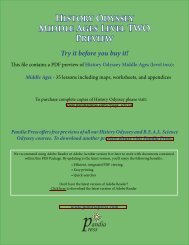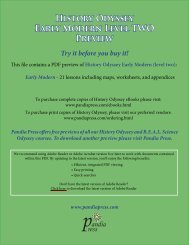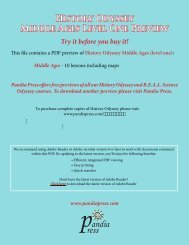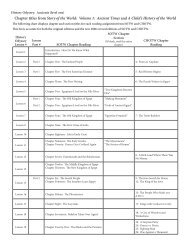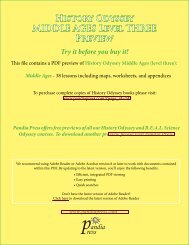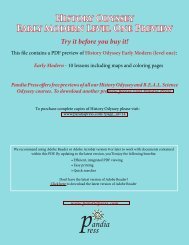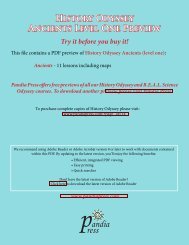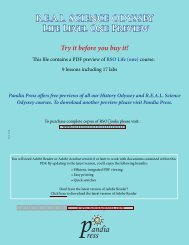History Odyssey - Modern Times (2) Sample lessons - Pandia Press
History Odyssey - Modern Times (2) Sample lessons - Pandia Press
History Odyssey - Modern Times (2) Sample lessons - Pandia Press
Create successful ePaper yourself
Turn your PDF publications into a flip-book with our unique Google optimized e-Paper software.
Between the Wars <strong>History</strong> <strong>Odyssey</strong>: <strong>Modern</strong> <strong>Times</strong> Level 2<br />
56<br />
Lesson<br />
Animal Farm<br />
GET READY For this lesson you will need:<br />
• Animal Farm by George Orwell<br />
q Begin reading Animal Farm. Continue with your<br />
<strong>lessons</strong> while you read. Finish before Lesson 62,<br />
where you will be given a writing assignment.<br />
The Russian Revolution -<br />
Make the Connection<br />
- 57 -<br />
connects World War I to the Russian Revolution,<br />
briefly record an effect of World War I that<br />
played a role in causing the Russian Revolution.<br />
(One connection between WWI and the Russian<br />
Revolution is already written on the worksheet.<br />
Find another, and write it below the arrow.) You<br />
can find many of these connections in your KFH<br />
readings and Web site research.<br />
You will be adding to this worksheet throughout<br />
the rest of this course, making connections<br />
between events set in motion by World War<br />
I. Many events are already written on the<br />
worksheet. When you connect one event to<br />
another, draw an arrow connecting the events<br />
and write details of the relationship above and<br />
below the arrow line. You are encouraged to<br />
find connections not suggested in this guide<br />
and to add events not already listed on the<br />
worksheet. You are expected to add to this<br />
worksheet as you discover connections.<br />
57<br />
Lesson GET READY For this lesson you will need:<br />
• KFH<br />
• Worksheet: Record of War or Conflict<br />
• Worksheet: Make the Connection<br />
q Read KFH pp. 394 – 395.<br />
Helpful Web sites:<br />
q Complete a Record of War or Conflict worksheet • www.johndclare.net/Russ_Rev_Emsleyand%20<br />
for the Russian Revolution. Write the conditions Englander.htm<br />
taking place in Russia that contributed to the • http://en.wikipedia.org/wiki/Russian_Revolution_<br />
revolution. Briefly summarize the revolution and of_1917<br />
record the effects, including the name change to<br />
the Soviet Union, casualties, and immigration. q Add significant dates to your timeline.<br />
File the worksheet in your Wars & Conflicts<br />
section.<br />
q Add the Treaty of Brest-Litovsk to your<br />
Documents, Legislation, & Government section 58<br />
Lesson<br />
Communism<br />
along with a short summary.<br />
q Enter the following into your Men, Women, &<br />
Groups section: Czar Nicholas II (add to your<br />
former entry), Rasputin, Vladimir Lenin, the<br />
Bolsheviks, the White Russians, Leon Trotsky,<br />
and Joseph Stalin.<br />
q Although it was certainly not the only cause,<br />
there were many connections between World<br />
War I and the Russian Revolution. In fact, you<br />
might find that World War I was such a turning<br />
point in history that it became a catalyst for<br />
many future events, setting off a domino-like<br />
effect around the world for many years. Locate<br />
the poster titled “Make the Connection.” (Store<br />
the poster in your Summaries section as a<br />
two-page spread.) Along the first arrow that<br />
GET READY For this lesson you will need:<br />
• TSOM (optional)<br />
• Worksheet: The Communist Manifesto<br />
• Worksheet: Political Doctrine<br />
• Worksheet: Make the Connection<br />
• Encyclopedias, Internet, and/or library access<br />
One result of the Russian Revolution was the creation<br />
of modern communism. In 1848, Karl Marx and<br />
Frederick Engels wrote The Communist Manifesto,<br />
bringing the movement of communism into favor with<br />
revolutionaries such as Lenin and Tolstoy.<br />
q Read TSOM Chapter 59, Emancipation<br />
(optional). This chapter reviews the industrial<br />
revolution, slavery, and Abraham Lincoln. It also<br />
covers Karl Marx and the ideas of communism/<br />
socialism.
<strong>Pandia</strong> <strong>Press</strong><br />
q Read the excerpts from The Manifesto of the<br />
Communist Party.<br />
The entire Communist Manifesto can be read at:<br />
• www.marx.org/archive/marx/works/1848/<br />
communist-manifesto/index.htm.)<br />
In the Manifesto, the French terms bourgeoisie<br />
and proletariat are used repeatedly. Bourgeoisie<br />
(boor-zwha-zee) is used in a negative context,<br />
referring here to the middle/merchant class that<br />
embraces imperialism and exploits capitalism to<br />
make a profit off the backs of the working class<br />
(the proletariat). Proletariat (proh-luh-tair-eeuht)<br />
refers to the poorest working class, which<br />
possesses no capital and no property ownership<br />
and whose only means of survival is through<br />
selling their labor to the bourgeoisie. In Marx’s<br />
interpretation of capitalism, the proletariat<br />
had no means of advancing their situation to<br />
become part of the bourgeoisie.<br />
q After each section of the Manifesto, translate<br />
the meaning in your own words. (The first<br />
section is done for you.) Like many revolutionary<br />
documents, the Manifesto is often redundant<br />
and verbose. This style of writing was commonly<br />
used during revolutions to convey enthusiasm<br />
for the cause, overemphasize ideas, and ensure<br />
that the author effectively communicated his<br />
message. You should be able to translate each<br />
section into one or two concise sentences,<br />
concentrating on the central message. File<br />
the completed worksheet in your Documents,<br />
Legislation, & Government section.<br />
q Make a copy of the Political Doctrine worksheet<br />
and title it Communism. (Do not write on the<br />
original.) Consider the following questions as<br />
you complete the worksheet:<br />
• What is the definition of communism?<br />
• What are the advantages and disadvantages of<br />
communism?<br />
• Communism has been described as:<br />
People for the service of the government.<br />
Capitalism has been described as:<br />
Government for the service of the people.<br />
What do these statements mean? Why is<br />
capitalism considered to be the opposite<br />
of communism? What are the differences<br />
Part VI<br />
between these two ideologies?<br />
• How did modern communism begin? Where<br />
did it begin?<br />
• What were the conditions that allowed it to<br />
become popular?<br />
• Who were the communist leaders and how did<br />
they advance or hinder the movement? How<br />
did they differ?<br />
• Has any country ever achieved a true<br />
communist society? Why?<br />
• Is communism in practice today?<br />
You will need to do outside research in order to<br />
complete the worksheet. File the worksheet in your<br />
Documents, Legislation, & Government section.<br />
Helpful Web sites:<br />
• www.factmonster.com/ce6/history/A0813068.html<br />
• www.crf-usa.org/bria/bria19_2a.htm<br />
59<br />
Lesson<br />
q Add a connection to your Make the Connection<br />
poster. (Perhaps between the Russian<br />
Revolution and Communism.)<br />
Fascism<br />
GET READY For this lesson you will need:<br />
• KFH<br />
• Worksheet: Political Doctrine<br />
• Worksheet: Make the Connection<br />
q Read KFH pp. 398 – 399.<br />
q Complete a Political Doctrine worksheet<br />
for Fascism. Consider these questions while<br />
completing the worksheet:<br />
• What is the basic premise of fascism?<br />
• What advantages does it offer? What are its<br />
limitations?<br />
• What are the social, political, and economic<br />
goals of fascism?<br />
• How did this doctrine become popular? What<br />
were the conditions that allowed it to take hold?<br />
• How is the success of fascism dependent upon<br />
the charisma of the leader?<br />
- 58 -
Between the Wars <strong>History</strong> <strong>Odyssey</strong>: <strong>Modern</strong> <strong>Times</strong> Level 2<br />
• Where did fascism begin? Where did it spread<br />
and why?<br />
• How does fascism differ from socialism and<br />
communism? (Note: National Socialist party<br />
is a misnomer. Hitler and his followers were<br />
not socialists, but rather fascist, and became<br />
totalitarian fascists, as you will soon learn).<br />
File the worksheet in your Documents,<br />
Legislation, & Government section.<br />
q Add Benito Mussolini, Francisco Franco,<br />
Adolf Hitler, Nazis (National Socialist German<br />
Worker’s Party), and the Falange Party to your<br />
Men, Women, & Groups section.<br />
q Add another effect to your list of the outcomes<br />
of the Treaty of Versailles in relation to fascism<br />
in Germany.<br />
q Add connections to the “Make the Connection”<br />
worksheet. (Perhaps between World War I<br />
and Fascism, and between Communism and<br />
Fascism).<br />
q Add significant dates to your timeline.<br />
61<br />
Lesson<br />
Lesson<br />
60<br />
The Spanish Civil War<br />
GET READY For this lesson you will need:<br />
• KFH<br />
• Worksheet: Record of War or Conflict<br />
• Map 15, Spain<br />
• Atlas<br />
• Colored pencils<br />
• Fine-point black pen or pencil<br />
q Read KFH pp. 408 – 409.<br />
q Summarize The Spanish Civil War on a Record of<br />
War or Conflict worksheet.<br />
Informative Web site on the Spanish Civil War:<br />
• www.spartacus.schoolnet.co.uk/Spanish-Civil-War.<br />
htm<br />
q Add to your former entries on Francisco Franco<br />
and the Falange Party in your Men, Women, &<br />
Groups section.<br />
q<br />
On Map 15, Spain, use an atlas to shade<br />
Spain green and label the following:<br />
Spain<br />
North Africa<br />
Morocco<br />
Italy<br />
Bay of Biscay<br />
Barcelona<br />
Bilbao<br />
q Optional: Watch the movie For Whom the Bell<br />
Tolls (1943), starring Gary Cooper and Ingrid<br />
Bergman, and based on the novel by Ernest<br />
Hemingway. The setting for this movie is the<br />
Spanish Civil War.<br />
Socialism<br />
GET READY For this lesson you will need:<br />
• Worksheet: Political Doctrine<br />
• Worksheet: Make the Connection<br />
• KFH<br />
• Encyclopedias, Internet, and/or library access<br />
q Complete a Political Doctrine worksheet for<br />
socialism. Socialism is considered by many political<br />
scientists to be opposite of fascism, a rebuke of<br />
capitalism, and close to communism. The difference<br />
between communism and socialism has been<br />
described this way:<br />
Communism: From each according to his ability,<br />
to each according to his needs.<br />
Socialism: From each according to his ability,<br />
to each according to his deeds.<br />
Consider the following questions while completing<br />
the worksheet:<br />
• What is meant by the comparison of socialism to<br />
communism stated above?<br />
• What is the definition of socialism?<br />
• How does socialism differ from capitalism and<br />
fascism?<br />
• How did it develop and where?<br />
Madrid<br />
Portugal<br />
Atlantic Ocean<br />
Valencia<br />
Guernica<br />
Córdoba<br />
Mediterranean Sea<br />
- 59 -
<strong>Pandia</strong> <strong>Press</strong><br />
• What political economic conditions make socialism<br />
popular?<br />
You will need to research socialism to complete the<br />
worksheet. File the worksheet in your Documents,<br />
Legislation, & Government section.<br />
Suggested Web sites:<br />
• encarta.msn.com/encyclopedia_761577990/Socialism.<br />
html<br />
• en.wikipedia.org/wiki/Socialism<br />
• www.marxists.org/glossary/terms/s/o.htm#socialism<br />
q Add at least two more connections to your<br />
Make the Connection worksheet. (Hint: Fascism<br />
and Socialism to the Spanish Civil War)<br />
q Examine Pablo Picasso’s Guernica depicting<br />
the German bombing of that town during the<br />
Spanish Civil war on KFH p. 409.<br />
q Enter Pablo Picasso in your Literature,<br />
Technology, & Art section and include a copy of<br />
Guernica, if possible.<br />
This Web site discusses this important war painting, showing<br />
details and explaining their significance:<br />
• http://homepage.mac.com/dmhart/Teaching/<br />
Picasso2.html<br />
62<br />
Lesson<br />
Political Satire<br />
GET READY For this lesson you will need:<br />
• Animal Farm<br />
• Worksheet: Essay<br />
• Worksheet: Essay Rubric Checklist<br />
• Encyclopedias/Dictionary<br />
q Finish reading Animal Farm.<br />
In an essay titled “Why I Write,” George Orwell<br />
said, “Animal Farm was the first book in which I<br />
tried, with full consciousness of what I was doing,<br />
to fuse political purpose and artistic purpose into<br />
one whole.” In other words, Orwell wanted his<br />
readers to get a political message from reading<br />
Animal Farm. That makes Animal Farm a political<br />
satire. But what is the message Orwell was trying to<br />
convey? In the same essay, Orwell goes on to say,<br />
“The Spanish [Civil] War and other events in 1936-<br />
37 turned the scale . . . Every line of serious work<br />
Part VI<br />
that I have written since 1936 has been written,<br />
directly or indirectly, against totalitarianism and for<br />
democratic socialism . . . ”<br />
q Look up political satire and totalitarianism.<br />
Write definitions in your Summaries section.<br />
Orwell became a frustrated solider, fighting<br />
against General Franco in the Spanish Civil<br />
War. He was also disillusioned with the Soviet<br />
dictator, Stalin, during the Russian Revolution.<br />
He saw both of these revolutions resulting<br />
in regimes that were more tyrannical and<br />
suppressive than the ones they overthrew.<br />
In Animal Farm, a portrayal of the Russian<br />
Revolution, Orwell depicts socialism turning to<br />
oppressive totalitarianism (extreme fascism)<br />
in the hands of a power-hungry dictator. This<br />
“fairy tale” story presents a microcosm that<br />
parallels real historical tyranny in places like<br />
Spain, Italy, Germany, Japan, and Russia after<br />
World War I. Therefore, it is fitting that your<br />
writing assignment for Animal Farm involves<br />
deciphering its political message.<br />
q In about five paragraphs, describe how Animal<br />
Farm parallels political history. Specifically,<br />
how does the story represent the cycle of<br />
totalitarianism taking hold—a suppressed<br />
group of citizens, a strong leader emerging<br />
with promises of a better life, a revolution,<br />
harsh times, abuse of power, propaganda,<br />
and ultimate tyranny? In your essay, compare<br />
specific examples from the story to specific<br />
events in history. Also, describe how well<br />
Animal Farm depicts socialism, communism,<br />
fascism, and other political situations.<br />
Begin your essay with a detailed topic sentence<br />
that describes Animal Farm as a political satire.<br />
Your topic sentence might read, “Animal Farm<br />
by George Orwell offers an explanation of how<br />
a tyrannical ruler rises to power and exploits<br />
his fellow citizens.” Use quotes from the story<br />
and paraphrase events in the story to support<br />
your topic sentence. Describe the role certain<br />
characters played in advancing tyranny. Do not<br />
forget to provide a concluding paragraph. Use<br />
the Essay Worksheet and Essay Rubric Checklist<br />
to assist you in writing your essay. File your<br />
essay in your Literature, Technology, & Art<br />
section.<br />
- 60 -
Between the Wars <strong>History</strong> <strong>Odyssey</strong>: <strong>Modern</strong> <strong>Times</strong> Level 2<br />
Consider these questions as you write your<br />
essay:<br />
• What conditions were taking place on the farm<br />
that allowed a revolution to take place and<br />
a strong leader to emerge? How were these<br />
conditions similar to those in Spain or Russia<br />
during the Russian Revolution and the Spanish<br />
Civil War?<br />
• Which historic figures and events do the animals<br />
and their actions represent? For example, Old<br />
Major has been compared to Lenin and Marx,<br />
and Animalism to Communism or Socialism.<br />
• How does Animal Farm portray the nature of<br />
tyrants?<br />
• How are the animals able to be manipulated into<br />
following the dictator Napoleon?<br />
• What role did propaganda play?<br />
• How are socialism and fascism portrayed in the<br />
story?<br />
• Why was a socialist or communist community<br />
never achieved on Animal Farm?<br />
• How does Orwell’s support of socialism play a<br />
part in the story and affect the outcome?<br />
No Promises in the Wind<br />
U.S.A.<br />
GET READY For this lesson you will need:<br />
• KFH<br />
• TSOM (optional)<br />
q Read KFH pp. 400 – 401.<br />
q Read TSOM Chapter 66, The United States<br />
Comes of Age. (Optional)<br />
q Add Woodrow Wilson, Charles Lindbergh,<br />
Al Capone, Warren Harding, and Franklin<br />
Roosevelt to your Men, Women, & Groups<br />
section.<br />
q Add Prohibition to your Documents,<br />
Legislation, & Government section along with<br />
a short summary. Look up the 18 th and 21 st<br />
Amendments to the U.S. Constitution and<br />
record these in the same section.<br />
Web site:<br />
• www.usconstitution.net/const.html#Amends<br />
q Write a two- to three-paragraph summary<br />
of isolationism. List the advantages<br />
isolationism brought to the U.S.A. as well as<br />
the disadvantages. Include how and when<br />
isolationism ended for the U.S.A. File your<br />
summary in your Documents, Legislation, &<br />
Government section.<br />
63<br />
Lesson GET READY For this lesson you will need:<br />
• No Promises in the Wind by Irene Hunt<br />
q Add Skyscrapers, the Jazz Age, and Art Deco<br />
q Begin reading No Promises in the Wind.<br />
to your Literature, Technology, & Art section.<br />
Continue with your <strong>lessons</strong> while you read, but<br />
Include sketches and images as appropriate.<br />
finish before Lesson 66 where you will be given q Add significant dates to your timeline.<br />
a writing assignment.<br />
q Research paper reminder: By this time you<br />
should be completing the first draft of your<br />
paper. Share your first draft with your parent or<br />
65<br />
Lesson<br />
The Great Depression<br />
teacher and get feedback. Use the feedback to<br />
create a second draft.<br />
GET READY For this lesson you will need:<br />
64<br />
Lesson<br />
• KFH<br />
• Worksheet: Make the Connection<br />
• Worksheet: The Great Depression<br />
• Colored pencils<br />
• Encyclopedias, Internet, and/or library access<br />
q Read KFH pp. 404 – 405.<br />
q Add another effect to your list of the outcomes<br />
- 61 -



